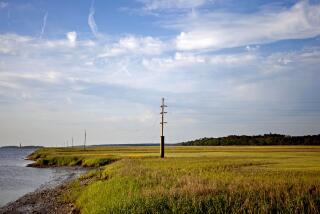Historic Home Owners Are Fighting Back
- Share via
When Elmyra Taylor’s Hanover, Va., home was included in a historic district against her wishes, she retaliated by planting pink flamingo lawn ornaments in her yard.
Taylor’s slap at historic preservation--she considers the birds the epitome of bad taste--is but one act of defiance by landowners who claim their private property rights are threatened by intrusive and unwarranted government regulation.
While many of the issues championed by the property rights movement are limited to rural areas, Taylor’s historic preservation grievance over land she owns just outside the state capital of Richmond is one that tends to ensnare city dwellers as well as rural land owners.
Although Taylor is not a card-carrying member of the private property rights movement that has blossomed over the past few years, she said she empathizes with the frustration that bubbles up over government rules that encumber the rights of individuals to do with their property as they see fit.
Taylor, on the one hand, said she fully endorses the preservation of the 1735 Hanover County Court House, one of the oldest in America, where a picture of her grandfather hangs.
Yet she chafes against restrictions placed four years ago on her 20th-Century home, which she describes as “plain and boxy,” because it fell in a 43-acre district designed to preserve the historic character surrounding the Colonial era building.
“I cannot paint my house, I cannot paint the fence, I cannot remove trees or tree limbs without permission from an architectural review board and county supervisor, who have been most unreasonable,” she said.
Hanover Planning Director John Hodges countered that the district serves to protect the historic integrity of the area, lest a new building or alteration to existing property prove “out of character” with the surroundings. However, he added, local officials are examining ways to remove some of the “more oppressive” restrictions facing homeowners there.
Other landowners are rebelling against restrictive controls placed on their historic properties by calling for compensation from the government bodies that set the rules.
The matter reached a boil last summer when the Pennsylvania Supreme Court held that Philadelphia’s historic preservation law was unconstitutional under state law. The justices ruled that the historic designation of the Art Deco Boyd’s Theatre over the owner’s protests amounted to confiscation by the city, giving it a choice between paying up or backing off.
Although the Boyd’s case is now under reconsideration, property activists and historic preservation supporters both agree that the original verdict could inspire owner revolts elsewhere.
Coincidentally, the Virginia Department of Historic Resources recently began studying whether to reimburse owners for property designated as historic landmarks, which could include the 19 Civil War battlefields across the state currently up for consideration.
Alice Menks, president of the newly formed Virginians for Property Rights, based in Madison, Va., said she suspects what the government officials will recommend. “It is like asking the fox to guard the chicken house and whether he wants to pay for the chickens or not,” she said.
The National Trust for Historic Preservation is not taking idly the threat posed by the irate property rights groups. Since October, it has been working on a special initiative to form an alliance with the environmental, land use control and growth management groups to fight back, said the former president of the National Trust, J. Jackson Walter.
The idea, Walter said, is to balance the “absolutist” concept that “nobody can regulate or touch (someone’s property) without paying for it” against the property’s impact on neighboring landowners or the community at large.
More to Read
Sign up for Essential California
The most important California stories and recommendations in your inbox every morning.
You may occasionally receive promotional content from the Los Angeles Times.












